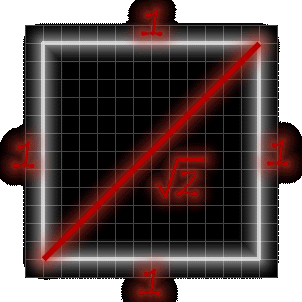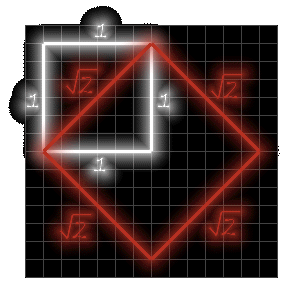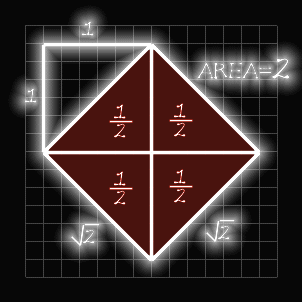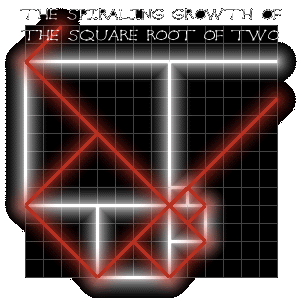- Lesson One: The Number One
- ... in Geometry
- ... in Nature
- ... in Culture
- "Uroboros" (related artwork by the author)
- "Creation" (related artwork by the author)
- Lesson Two: The Square Root of Two
- ... in Geometry
- ... in Nature, Part 1
- ... in Nature, Part 2
- ... in Culture, Part 1
- ... in Culture, Part 2
- "Duality" (related artwork by the author)
- Lesson Three: The Square Root of Three
- ... in Geometry
- ... in Nature
- ... in Culture
- "Vesica" (related artwork by the author)
- Lesson Four: Phi, or the Golden Proportion
- ... Intro, Part 2
- ... Intro, Part 3
- ... in Geometry
- ... in Nature
- ... in Nature, Part 2
- ... in Culture
- "The Flower of Phi" (related artwork by the author)
- Lesson Five: The Five Perfect Solids
- ... Intro, Part 2
- ... The Tetrahedron
- ... The Octahedron
- ... The Cube
- ... The Icosahedron
- ... The Dodecahedron
The square root of two is generated from the perfect square - symbol of the unified universe, as we learned in the last chapter. As stated at that time, the square represents the unified universe poised for manifestation, and it is here that we shall find out why this is so. The symbolism is quite obvious once understood, although this is not to say that its implications are not profound. In fact, the truth is quite the opposite.
 Original artwork created by A. O'Connor for Nature's Word using Adobe Photoshop 5.0.
Original artwork created by A. O'Connor for Nature's Word using Adobe Photoshop 5.0.First, start with the perfect square.
 Original artwork created by A. O'Connor for Nature's Word using Adobe Photoshop 5.0.
Original artwork created by A. O'Connor for Nature's Word using Adobe Photoshop 5.0.Now draw a line from one corner of the square to the corner diametrically opposed to it.
If we assume that the length of any given side of the square is equal to one, then the length of the diagonal line that we have just drawn equals the square root of two. It is as simple as that.
One must understand what the term "square root" pertains to in order to begin to understand the nature of this number's meaning, and in this particular case (the number two), that also means understanding irrational numbers. For most of us, the term "square root" is simply which number times itself equals the number at hand. As an example, the square root of four equals two, because two times two equals four (2 X 2 = 4). In another, more pertinent example, the square root of two equals 1.4142..., because 1.4142... multiplied by equals two.
Of course, this number is irrational, having no definite value because its integers continue past the decimal point for an infinite number of digits. Thus we could never actually multiply the square root of two times itself and obtain the number two - our end product would be very, very close to two, but would not actually equal two. Irrational numbers such as this one, and others such as pi and phi (3.1415... and 1.6180339..., respectively), possessed special significance for ancient sacred geometers, and this is especially true for the Greeks and their able predecessors, the Egyptians. Both believed that irrational numbers always represent archetypal principles of some sort, whereas rational, definite numbers were always related to form the material world. In other words, numbers which cannot be measured definitely relate to the archetypal realm, which also cannot be measured with definition, whereas definite numbers relate directly to the finite, material world, which on the surface appears to be measurable with relatively precise definition.
 Original artwork created by A. O'Connor for Nature's Word using Adobe Photoshop 5.0.
Original artwork created by A. O'Connor for Nature's Word using Adobe Photoshop 5.0.But let us return to understanding what makes a square root a square root. The term square root is much more literal than most people realize, because it denotes a line whose length can be used to generate a square with an area equal to the number in question. In other words, a line which measures 1.4142... can be used to generate a square whose internal area is equal to two. Here's how - we simply take the line measuring 1.4142... and make it the side of a new square (see figure at left). As most people know, the area of any square or rectangle can be determined by multiplying the shape's length by the width, in this case 1.4142... multiplied by 1.4142... As we already know, our equation equals two.
 Original artwork created by A. O'Connor for Nature's Word using Adobe Photoshop 5.0.
Original artwork created by A. O'Connor for Nature's Word using Adobe Photoshop 5.0.Here we come across one of the perfect paradoxes of sacred geometry, mentioned earlier in the text. If we take unity, the perfect square whose sides and area are equal to one (the square in the upper left corner of the diagram at left), and we connect its opposite corners with a diagonal we obtain the square root of two. Then we take that square root of two line and make a new square out of it, using it as the new square's edge. As we see in the diagram at left, the new square's area equals two, being made up of four halves of our original square, whose area was equal to one. In this way, we have divided unity in half by cutting it with our square root of two line, and yet implied double of the original unity in the process. Here, with the first division of unity, we find a finger pointing us in the direction of understanding the paradox that multiplicity within unity is not only possible, but in fact is directly implied by its very existence.
 Original artwork created by A. O'Connor for Nature's Word using Adobe Photoshop 5.0.
Original artwork created by A. O'Connor for Nature's Word using Adobe Photoshop 5.0.Partly because of this doubling effect it is not only the number two that relates directly to the ideas inherent in the square root of two, but two times two (four), and two times that (eight), and two times that (sixteen), and on and on. Also, if we work with the actual geometric figures that produce the square root of two and its related numbers, we find that two automatically implies four, which implies eight, and eight sixteen, etc. I will leave this discovery, and the many others which spawn from working with the geometry of the square root of two, to the reader.


